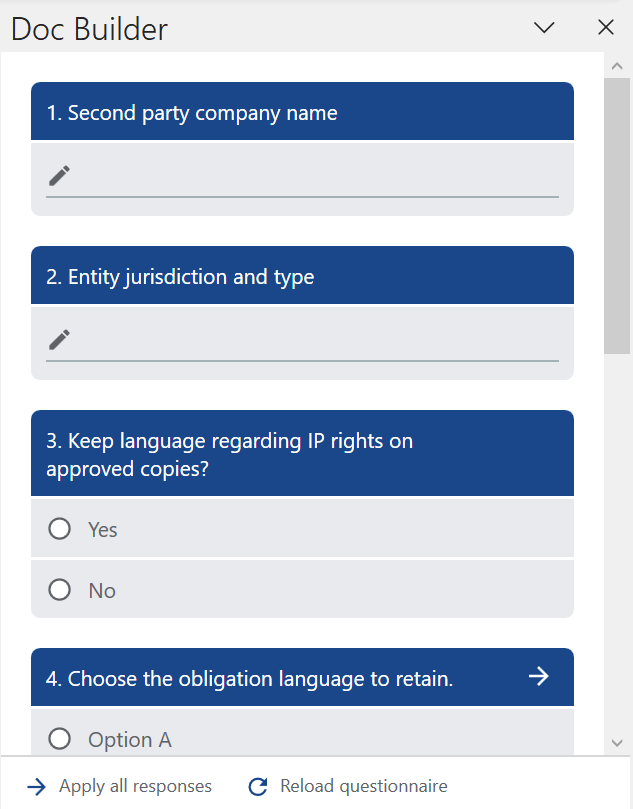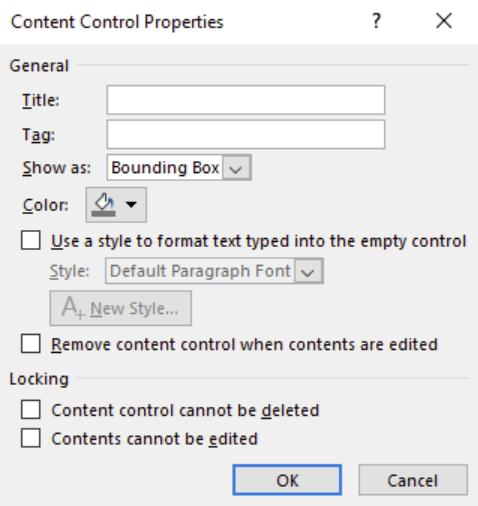Doc Builder
Overview
Organizations often have a repository of standard documents—perhaps in a Macabacus library—containing boilerplate language that is customized for particular use cases. Examples include internal memos, legal documents such as non-disclosure agreements and contracts, and regulatory filings. Customization often requires the author to comb through the document and remove inapplicable sections, copy and paste content from other documents, find and replace names throughout the document, and carefully proofread the document to ensure that no necessary changes were overlooked.
Access
Access to this tool requires Enterprise subscribers. In the past, it was available to any customer with access to Macabacus' Word tools, with the caveat that access would eventually be restricted to Enterprise subscribers. Builder facilitates document creation by automating and simplifying many of these tasks with an easy-to-use questionnaire that prompts authors to retain or discard sections of a document, choose from boilerplate language alternatives, and populate text fields throughout a document.

Doc Builder facilitates document creation by automating and simplifying many of these tasks with an easy-to-use questionnaire that prompts authors to retain or discard sections of a document, choose from boilerplate language alternatives, and populate text fields throughout a document.
Usage
When you create a new document from a Macabacus library template using the Macabacus > New menu, Macabacus automatically scans the document for content that requires author input. If any such content is found, the Doc Builder questionnaire opens at the edge of the Word window. Any autofill fields in the new document will populate automatically (unless you have chosen to preview them).
You can also open the Doc Builder pane manually, if the active document has unpopulated questions or autofill fields, by toggling the Macabacus > Doc Builder button.
Features
Questions
The Doc Builder questionnaire may include three types of questions:
- Yes / No — Yes/no questions prompt you to retain or discard content within the document. If the content in question is not applicable to your document, select "No." Otherwise, select "Yes."
- Multiple Choice — Multiple choice questions let you choose from two or more content alternatives. Unselected options are discarded.
- Text Input — Text inputs prompt you to enter text to populate placeholders within the document. If multiple identical placeholders are found in the document, you have the option to populate all such placeholders at once.
After providing a response to a question, a button showing an arrow icon will appear in the question header. Click this button to apply the response to this question, only, or click the Apply all responses button at the bottom of the Doc Builder pane to apply responses to multiple questions at once. If you apply a response to a question and then undo the resulting change to the document, click the Reload questionnaire button at the bottom of the Doc Builder pane to restore the removed question.
Click the dark blue question header or select a response to navigate to the question within the document.
Autofill Fields
Unlike the three question types described above, which all require user input to manipulate content, autofill fields populate predefined text automatically and transparently when a new document is created from a Macabacus library template. No action is required by the user to use this feature. Autofill fields are appropriate for populating information that is always the same for the same user (e.g., company name, last name).
Alternatively, you can preview autofill fields in the Doc Builder pane and apply them manually. If you choose to preview autofill fields, they appear as text input questions described above, but with pre-populated responses, as shown in question #1 in the image above. To preview autofill fields, check the appropriate box in the Word > Doc Builder section of Macabacus' Settings dialog.
Autofill fields are similar in concept to what Word's native Quick Parts and AutoText features, fields, and/or custom document properties are broadly intended to accomplish, but are far more intuitive to use, configure, and standardize.
Configuration
The questions posed in the Doc Builder questionnaire are populated from content controls within the document that are configured by you or your Macabacus account administrator prior to publishing the document template to a Macabacus library. If you are unfamiliar with content controls, please review Microsoft's documentation on this native feature. If the Developer tab is not visible in Word, see these instructions to show it.
Macabacus uses a content control's title property for messaging in the Doc Builder user interface. The title populates either the dark blue question header (pictured above), or the available options in the case of multiple choice questions. The tag property, which is not visible to users, contains a code that Macabacus uses to identify the content control as a Doc Builder question, option, or autofill field. Macabacus supports both rich text and plain text content controls, although the former provides flexibility in working with content other than text (e.g., tables, images).
Live Testing
As you add questions and autofill fields to your document as described below, you should check your work live. Before adding autofill fields to your document, enable the preview option in the Word > Doc Builder section of Macabacus' Settings dialog. After adding your first question to your document, click the Macabacus > Doc Builder button to see how the question appears to end users. Leave the Doc Builder pane open as you add questions, clicking the Reload questionnaire button periodically to refresh the pane. When you add a question, simulate a response and review the results for expected behavior, then undo the resulting change and click the Reload questionnaire button to restore everything to its pre-response state.
Text Selection
Be sure that the selected text or other content around which you wrap content controls as described below contains leading and/or trailing spaces and/or newlines, as desired. For example, when creating a yes/no question for a sentence in the middle of a paragraph, it may be necessary to select the sentence's leading, rather than trailing, space(s) to achieve the desired effect. After adding a content control, double check that it wraps the expected text and spaces. To facilitate making proper selections, you may want to show paragraph marks and other formatting symbols by clicking the pilcrow () button on Word's Home tab.

Yes / No Questions
To create a yes/no question:
- Select the content (e.g., paragraph) intended to be retained or discarded and click the
Developer > Controls > Rich Text Content Controlbutton to wrap a content control around the selection. - Click the
Controls > Propertiesbutton on the same tab to open Word'sContent Control Propertiesdialog. - Populate the title property with language that provides clear instruction to the user and is contextually consistent with the only available responses to this type of question—"Yes" and "No." An example would be, "Do you want to keep the termination provisions section?" The title is the text that appears in the blue question header in the Doc Builder pane.
- Populate the tag property with the text
q_ynto instruct Macabacus to treat this content control as a yes/no question.
Multiple Choice Questions
To create a multiple choice question:
- Select two or more content alternatives (e.g., paragraphs) and click the
Developer > Controls > Rich Text Content Controlbutton to wrap a content control around the selection. - Click the
Controls > Propertiesbutton on the same tab to open Word'sContent Control Propertiesdialog. - Populate the title property with language that provides clear instruction to the user and is contextually consistent with the available responses to this question. An example would be, "Select language for the termination provision." The title is the text that appears in the blue question header in the Doc Builder pane.
- Populate the tag property with the text
q_mcto instruct Macabacus to treat this content control as a multiple choice question.
For each individual content alternative (i.e., option), perform the following steps:
- Select it and wrap it in a content control as in steps #1 and #2 above.
- Populate the title property with concise language that summarizes the option. The title is the text that appears next to each option listed in the Doc Builder pane.
- Populate the tag property with the text
q_mc_optto instruct Macabacus to treat this content control as a multiple choice option.
Nesting Options
Content controls for multiple choices options must be wholly contained within the content control for the question to which those options apply.
Text Input Questions
To create a text input question:
- Select the text in your document that you want to designate as a text placeholder, or alternatively place the cursor where you want the placeholder to be inserted, and click the
Developer > Controls > Rich Text Content Controlbutton to insert a content control. - Click the
Controls > Propertiesbutton on the same tab to open Word'sContent Control Propertiesdialog. - Populate the title property with language that provides clear instruction to the user and is contextually consistent with this type of question. An example would be, "Company name" The title is the text that appears in the blue question header in the Doc Builder pane.
- Populate the tag property with the text
q_text_[field_name]to instruct Macabacus to treat this content control as a text input question. Examples includeq_text_company_nameandq_text_ceo_name.
You can create text placeholders with the same tag property throughout a document so that all placeholders can be populated at once by the user.
Autofill Fields
Before creating autofill fields in your document templates as described below, it is recommended that you first define autofill fields in the Word > Doc Builder section of Macabacus' Settings dialog. Autofill fields can be locked to prevent modification by end users, or unlocked to allow users to set autofill values specific to them. After defining your autofill fields, share these settings with other Macabacus users.
To create an autofill field:
- Select the text in your document that you want to designate as a text placeholder, or alternatively place the cursor where you want the placeholder to be inserted, and click the
Developer > Controls > Rich Text Content Controlbutton to insert a content control. - Click the
Controls > Propertiesbutton on the same tab to open Word'sContent Control Propertiesdialog. - Populate the tag property with the text
q_auto_[field_name]to instruct Macabacus to treat this content control as an autofill field. Examples includeq_auto_first_nameandq_auto_last_name. The[field_name]portion of the tag property must match theTagcolumn of one of the autofill fields defined in theWord > Doc Buildersection of Macabacus'Settingsdialog.
This documentation refers to the latest Macabacus version. Some features and descriptions of these features may not apply to older versions of Macabacus. Update your Macabacus software to take advantage of the latest features.